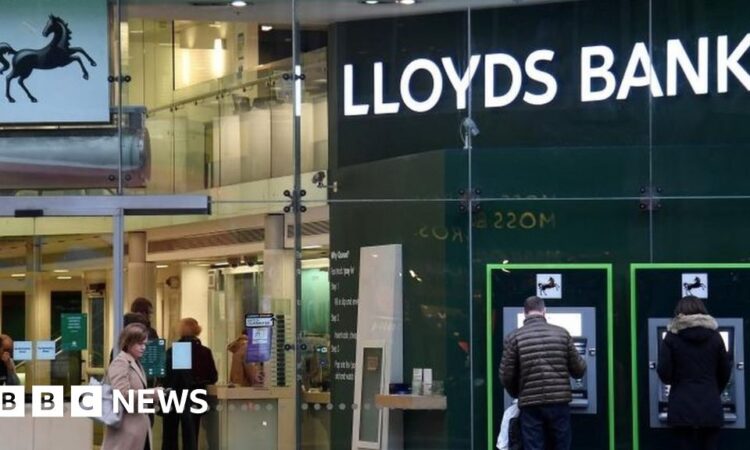
- By Michael Race
- Business reporter, BBC News
Lloyds has posted bumper profits as the UK’s biggest mortgage lender continues to benefit from higher interest rates.
The banking group revealed a pre-tax profit of £1.9bn for the three months to September, up from £576m in the same period last year.
The latest results follow concerns banks are raising borrowing rates much faster than they are savings rates, particularly for easy access accounts.
But banks including Lloyds have defended themselves against criticism.
Most banks have reported higher profits due to rising interest rates, as customers pay more to borrow cash for mortgages, loans and credit cards.
Lloyds, which also owns Halifax and Bank of Scotland, made £3.4bn in net interest income over the quarter.
But the figure was down slightly on the previous quarter as the bank paid more out to savers.
Since 2021 the Bank of England has repeatedly put up the UK’s benchmark interest rate, which informs rates set by High Street lenders such as Lloyds, in a bid to tackle soaring consumer prices.
The Bank left rates unchanged at its last meeting in September, at 5.25%, but they remain at their highest level since 2008, leaving many homeowners and first-time buyers under pressure.
The average rate on a fixed two-year mortgage deal is currently 6.24%, according to financial information service Moneyfacts.
The average easy access savings rate, the most common on the market, is 3.21%.
On Tuesday, Barclays reported profits before tax of £1.89bn for the three months to September, down slightly from £1.96bn for the same period in 2022. The bank took in £1.58bn in net interest income over the quarter as a result of higher rates.
Santander posted UK profits before tax of £1.73bn in the nine months to September, also driven by higher rates.
Mike Regnier, UK chief executive of the Spanish-owned group, said on Wednesday the bank had “prioritised” the needs of customers by “offering the right products and services as well as support with their finances when they need it”.
“We provided competitive rates for savers, including a top-of-market easy access savings account, and helped homeowners struggling with rising rates,” he added.
Last month, Santander decided to withdraw an easy access account with a rate of 5.2% “following significant demand”. It said the product was a “limited edition”.
The lender offers another savings account with a 7% return for current account holders only, according to MoneySavingExpert. The website shows smaller banks and building societies, not the likes of Lloyds and Barclays, are typically offering the best savings deals on the market.
Under new rules brought in by the Financial Conduct Authority (FCA), banks must now prove they are offering their customers fair value.
Charlie Nunn, group chief executive at Lloyds, said in a trading statement on Wednesday that the bank remained “focused on supporting our customers and helping them navigate the uncertain economic environment”.
Lloyds said it had seen more customers move cash out of current accounts and into savings accounts.
Some £11.1bn more was withdrawn from Lloyds current accounts in September than in the same month last year, with the amount of cash put into savings accounts increasing by 5%.
Matt Britzman, equity analyst at Hargreaves Lansdown, said Lloyd’s performance was helped by it managing to “keep hold of savers looking for better rates”.
“As we’ve seen over recent quarters consumers are conscious of the rates they’re receiving on current account deposits and are off in search of higher yields,” he said.
“Consumers facing higher living costs may not be feeling any release of pressure, but they’re managing finances well and remain remarkably resilient, with arrears levels stable.”
While interest rates have driven profits for Lloyds, the bank said its operating costs had risen due to inflation and also wage growth.
Santander warned it expected interest rates to be higher for longer and to “have a more pronounced impact on households and businesses”.
It comes as economists expect rates to be held by the Bank of England next week, with recent economic statistics suggesting higher borrowing costs are dragging on the economy.






